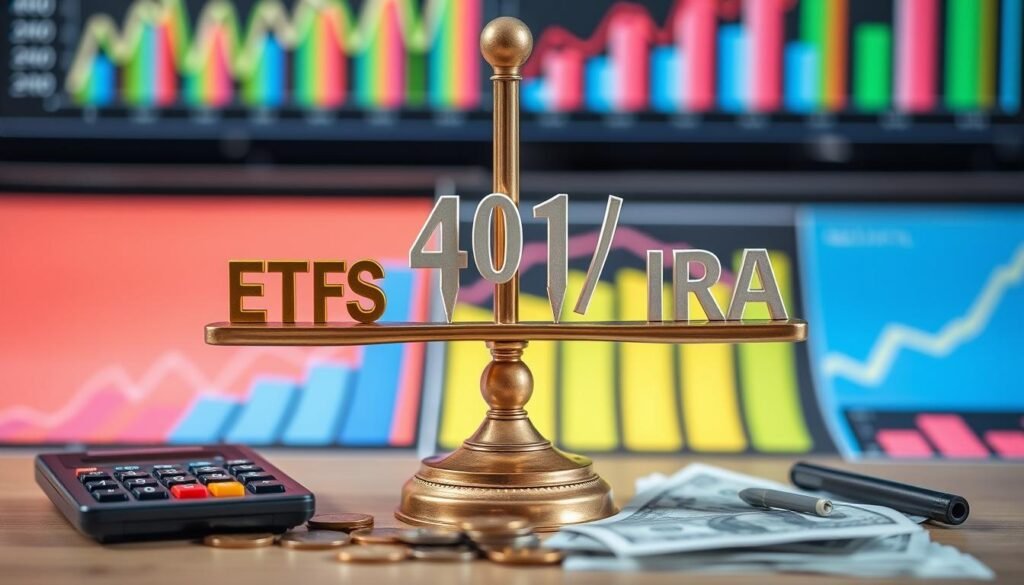In 2024, you could save up to $23,000 in a 401(k) if you’re under 50. If you’re 50 or older, you could save up to $30,000. These high limits make 401(k)s a great choice for planning your retirement. IRAs and ETFs also offer benefits, meeting different financial needs and tastes.
When you start investing for retirement, knowing the benefits of each option is key. ETFs are flexible and cost-effective. 401(k)s, on the other hand, offer employer matching, which can greatly increase your savings. IRAs provide tax benefits and a wide range of investment choices, adding to your retirement planning flexibility.
Understanding these retirement plans helps you make smart choices. By looking into ETFs, 401(k)s, and IRAs, you can use their special features to secure your financial future in retirement.
Key Takeaways
- 401(k) plans have high contribution limits: up to $23,000 for under 50 and $30,000 for 50 or older in 2024.
- ETFs provide flexibility, lower costs, and intraday trading options compared to mutual funds.
- IRAs offer significant tax advantages and a variety of investment choices.
- Employer matching in 401(k)s can significantly enhance your retirement savings.
- Combining ETFs, 401(k)s, and IRAs can help create a diverse and flexible retirement portfolio.
Understanding ETFs: A Versatile Investment Tool
Exchange Traded Funds (ETFs) are popular among investors. They manage over US$11.1 trillion globally and offer more than 9,149 options. About 70% of US advisors suggest ETFs to their clients, showing their key role in investing and retirement planning.
What Are ETFs?
ETFs are traded like stocks but hold a mix of assets like mutual funds. They track specific market indexes, making it easy to invest in various areas. For example, Schwab ETFs have low costs, making them efficient.
ETFs and Market Exposure
ETFs are great for getting broad market exposure. They cover many asset classes, from stocks to real estate. This helps investors match their portfolios to specific indexes, making their investments more diverse.
For instance, over 3,000 ETFs, including Schwab’s, are available without commission. This makes it easy and affordable to invest in the market.
Benefits of ETFs in Retirement Planning
ETFs are essential for retirement planning. They offer a mix of investments at low costs. This helps manage risks and aims for growth.
ETFs are also liquid, allowing for easy trading during market hours. This flexibility is great for those saving for retirement.
ETFs are also cost-effective and transparent. Their popularity is growing, especially among millennials. This makes ETFs a key part of investment and retirement plans for the future.
Overview of 401(k) Plans
401(k) plans are a key part of retirement savings for many workers. They help people save for the future in a simple way. These plans include employer contributions, limits on how much you can save, and many investment choices.

Employer-Sponsored Retirement Accounts
401(k) plans are set up by employers to help employees save for retirement. Workers can put part of their income before taxes into these accounts. This lowers their taxes for the year.
Employers also add money to these accounts, matching what employees contribute. This encourages workers to save more.
Contribution Limits and Employer Match
Knowing the contribution limits is key to saving more for retirement. In 2024, you can contribute up to $23,000 to a 401(k), with an extra $7,500 if you’re 50 or older. These limits will be $23,500 and $11,250, respectively, in 2025 for those 60 to 63, thanks to the Secure 2.0 Act.
Together, you and your employer can save up to $69,000 a year if you’re under 50. If you’re 50 or older, the limit is $76,500.
| Age Group | Contribution Limit (2024) | Contribution Limit (2025) | Catch-Up Contributions | Combined Limit (Under 50) | Combined Limit (50+) |
|---|---|---|---|---|---|
| Under 50 | $23,000 | $23,500 | N/A | $69,000 | N/A |
| 50+ | $23,000 | $23,500 | $7,500 | N/A | $76,500 |
| 60-63 | N/A | $34,750 | $11,250 | N/A | N/A |
Investment Options Within 401(k) Plans
401(k) plans offer many investment choices. You can pick from mutual funds, which mix stocks, bonds, and more. This helps diversify your investments.
Whether you want to play it safe or aim for higher returns, there’s an option for you. These plans help you build a portfolio that fits your financial goals.
As your career grows, so can your retirement savings. Your investment choices can change with you, keeping pace with your needs and the market.
The Flexibility and Control of IRAs
Individual Retirement Accounts (IRAs) offer unmatched flexibility and control in retirement planning. You can pick the IRA that fits your financial goals and tax preferences. Let’s explore the types of IRAs, investment choices, and tax rules.
Types of IRAs: Traditional vs. Roth
There are mainly two IRAs: traditional and Roth. Each has its own rules and benefits:
- Traditional IRA: Contributions are tax-deductible, and the account grows tax-free. But, you’ll pay taxes on withdrawals in retirement. For 2024, you can contribute up to $7,000 if under 50, and $8,000 if 50 or older.
- Roth IRA: You contribute with after-tax dollars, so no tax deduction. But, the growth and withdrawals in retirement are tax-free. Contribution limits for 2024 are the same as the traditional IRA.
Investment Choices in IRAs
IRAs offer a wide range of investment choices, unlike 401(k)s. You can invest in:
- Stocks and Bonds
- Mutual Funds and ETFs
- Real Estate
- Precious Metals
- Commodities
- Private Equity and Partnerships
Self-directed IRAs let you diversify and potentially earn more by investing in non-traditional assets. They offer more control and a customized investment plan.
Tax Implications and Withdrawal Rules
The tax rules and withdrawal rules vary between traditional and Roth IRAs:
Traditional IRA: Contributions are tax-deductible, leading to tax-deferred growth. But, withdrawals are taxed. You must start taking RMDs at age 73.
Roth IRA: Contributions are made with after-tax dollars. Growth and withdrawals in retirement are tax-free. Plus, there are no RMDs, allowing funds to grow indefinitely.
It’s important to talk to a financial advisor to understand IRA options. Choose the one that best fits your long-term financial goals.
| Feature | Traditional IRA | Roth IRA |
|---|---|---|
| Tax Treatment | Tax-Deductible Contributions | After-Tax Contributions |
| Withdrawal Taxes | Taxed on Withdrawal | Tax-Free Withdrawals |
| Required Minimum Distributions (RMDs) | Begin at age 73 | No RMDs |
| Contribution Limits (Under 50) | $7,000 | $7,000 |
| Contribution Limits (50+) | $8,000 | $8,000 |
Both traditional and Roth IRAs have unique benefits. Understanding these can help you maximize your retirement savings. Evaluate your financial situation and goals to choose the right IRA for you.
Comparing Costs: ETFs, 401(k)s, and IRAs
It’s important to know the costs of ETFs, 401(k)s, and IRAs for good financial planning. The costs of these retirement options can greatly affect your returns over time.
Understanding Expense Ratios
Expense ratios help us see how much a fund costs. These fees are a percentage of the fund’s assets each year. They cover the fund’s management and operational costs. ETFs and mutual funds in 401(k)s usually have expense ratios between 0.1% and 0.5%. IRAs, on the other hand, often have lower costs and more investment choices.

Fees and Commissions
There are other costs like trading commissions and management fees. These can increase your investment costs. For example, about 95% of workers pay fees for their 401(k) plans, with an average of 0.45%. But, these costs can change based on your investment choices. IRAs usually have fewer fees, making them good for financial planning.
The Impact of Costs on Long-Term Returns
The total cost of fees and expense ratios can really affect your investment’s growth. Lower costs mean your money can grow more over time. For example, if you max out your 401(k) in 2024, you’ll see better growth with low fees. IRAs also show the value of cost-effective investments, with $13.6 trillion in them by 2023.
| Investment Vehicle | Expense Ratios | Annual Contribution Limits (2024) |
|---|---|---|
| ETFs | 0.1% – 0.5% | N/A |
| 401(k) | 0.45% Average | $23,000 |
| IRA | Varies | $7,000 |
To get the most from your investments and reach your retirement goals, it’s key to understand the costs of ETFs, 401(k)s, and IRAs. Choose the most cost-effective options for the best results.
Tax Efficiency of ETFs and Mutual Funds in Retirement Accounts
Investing wisely in your retirement accounts can greatly improve your financial future. It’s important to consider the tax benefits of options like ETFs and mutual funds. Both have their own benefits, but ETFs are more tax-efficient.
ETFs are often more tax-efficient than mutual funds. This is because of how they handle capital gains. ETFs don’t distribute capital gains to shareholders like mutual funds do. Instead, they use a process that leads to fewer taxable events. This makes ETFs a great choice for tax-advantaged accounts like IRAs and 401(k)s.
When it comes to long-term capital gains, ETFs offer a smoother ride. These gains are taxed at lower rates: 0%, 15%, or 20%, depending on your tax bracket. Short-term capital gains, for investments held less than a year, are taxed at your regular income tax rate.
“By strategically selecting tax-efficient investments like ETFs for your retirement accounts, you can potentially minimize your tax liability and maximize your compound growth over time.”
Mutual funds offer diversification and professional management but have higher costs and more capital gains distributions. ETFs have an average expense ratio of 0.44%, while mutual funds have 1.25%. This small difference can add up over time, affecting your returns.
| Investment Type | Capital Gains Distribution | Expense Ratio | 30-Year Growth on $10,000 |
|---|---|---|---|
| ETFs | Low | 0.44% | $57,435.19 |
| Mutual Funds | High | 1.25% | $10,000 less |
A $10,000 investment in an ETF with a 6% annual return can grow to $57,435.19 more than the same investment in a mutual fund with a 5.75% return over 30 years. This shows the big advantage of choosing tax-efficient options for your retirement portfolio.
Overall, ETFs are a good choice for retirement accounts because of their tax efficiency. But, it’s also important to consider the tax benefits and advantages of both ETFs and mutual funds. This helps you make the best investment strategy for your retirement goals.
Investing – Grow Your Wealth: Strategies for Retirement
Effective investment strategies are key to growing wealth and a comfortable retirement. Diversifying your portfolio and choosing between passive and active management are important. Also, using risk management techniques helps create a strong plan that meets your financial goals.
Portfolio Diversification
A diversified portfolio is crucial for managing risk and steady growth. It includes ETFs, mutual funds, and other assets. This mix spreads risk, reducing the impact of poor investment performance.
For example, combining equities with fixed-income securities balances growth and stability. This approach helps manage investment risk effectively.
Passive vs. Active Management
Understanding passive and active management is important for your investment strategy. Passive management is cost-effective and follows a market index, ideal for long-term investors. Active management aims to beat the market through strategic choices, but it costs more.
Risk Management Techniques
Using risk management techniques is essential to protect your investments. These include stop-loss orders, diversification, and adjusting assets based on market conditions. Financial experts like Certified Financial Planners (CFP) and Chartered Financial Assistants (CFA) offer personalized advice.
It’s wise to start investing early to take advantage of compounding returns. The Rule of 72 helps estimate doubling time based on interest rates. For instance, an 8% interest rate can greatly increase your wealth, showing the value of early investment strategies.
The Role of Fractional Shares and Dividend Reinvestment
Investing in the stock market is easier now thanks to tools like fractional shares and dividend reinvestment plans. These tools help investors grow their portfolios, even with small amounts of money.
What Are Fractional Shares?
Fractional shares let you buy a part of a stock, not just the whole thing. For example, if a stock costs $1,000, you can invest $50. This makes it easier for more people to invest in stocks they want.
Benefits of Dividend Reinvestment
Dividend reinvestment plans (DRIPs) help you grow your portfolio by automatically investing dividends. Let’s say you own 1,000 shares of ABC Co. and it pays 50 cents per share. You earn $500. If you reinvest this, your wealth can grow a lot.
Starting with $20,000, you could have 1,069.55 shares worth $28,471 in three years. Over 20 years, reinvesting dividends could make you own 1,401.25 shares worth $188,664.30. This is a 47% increase in gains compared to taking dividends in cash.
How to Access Fractional Shares
Brokerages like Charles Schwab offer fractional shares. To get them, log in, go to the Trade tab, and pick Stocks & ETFs. You can then invest any amount you want, buying fractional shares.
Setting up DRIPs with Schwab makes reinvesting easy. Schwab’s DRIP service is free, but dividends are taxed in non-retirement accounts. It’s important to talk to financial planners and tax advisors to make sure these strategies fit your goals and taxes.
By using fractional shares and dividend reinvestment, you can make the most of your investments. This way, you can grow your wealth over time.
- Login to your brokerage account.
- Navigate to the Trade tab, select Stocks & ETFs.
- Choose the Reinvest Dividends checkbox for new positions.
- For existing holdings, go to the Accounts tab, select Positions, and set up DRIP through the Reinvest? column.
Using fractional shares and dividend reinvestments can help you maximize your investments. This way, you can grow your wealth over time.
| Investment Strategy | Initial Investment | Shares After 20 Years | Value After 20 Years |
|---|---|---|---|
| Reinvesting Dividends | $20,000 | 1,401.25 | $188,664.30 |
| Taking Dividends in Cash | $20,000 | 1,000 | $134,640 |
Contribution Limits and Tax Benefits of 401(k)s and IRAs
When planning for retirement, it’s key to know about tax benefits and contribution limits for 401(k)s and IRAs. Both offer tax perks that can boost your retirement savings. Understanding these can greatly help your financial health in the long run.
In 2023, traditional and Roth IRAs have a contribution limit of $6,500. This goes up to $7,500 for those over 50. In 2024, you can contribute $7,000 and $8,000, respectively. Traditional IRAs also have income limits for deductions, based on your filing status.
For example, in 2024, singles can deduct if they earn less than $73,000. Married couples need to earn under $218,000. Roth IRAs have income limits for full contributions. In 2024, singles can contribute fully if they earn less than $146,000. Partial contributions are allowed up to $161,000.
A spousal IRA is great for married couples. It lets a non-working spouse contribute, boosting your savings. But, watch out for IRS rules to avoid penalties. Excess IRA contributions face a 6% tax unless withdrawn before taxes.
For 401(k) plans, the 2025 limits are $23,500 for those under 50 and $31,000 for those over 50. It’s wise to contribute enough to your 401(k) to get your employer’s match. Then, aim to contribute up to the maximum allowed in your 401(k) plan.
| Retirement Account | 2023 Contribution Limits | 2024 Contribution Limits | 2025 Contribution Limits |
|---|---|---|---|
| Traditional & Roth IRAs | $6,500 ($7,500 for 50+) | $7,000 ($8,000 for 50+) | $7,000 ($8,000 for 50+) |
| 401(k) Plans | $22,500 ($30,000 for 50+) | $23,000 ($31,000 for 50+) | $23,500 ($31,000 for 50+) |
Diversifying your investments in these accounts is key to managing risk. While 401(k)s have limited options, IRAs offer more, like mutual funds and stocks. This diversity helps protect your investments.
Using both 401(k)s and IRAs wisely means following contribution limits and taking advantage of tax advantages. By planning your contributions well, you build a strong, tax-efficient path to a secure financial future.
Why ETFs Are a Game-Changer for Retirement Investing
ETFs have changed how people invest for retirement. They offer broad diversification, are cost-effective, and efficient in taxes. These qualities make ETFs a great choice for building a strong and adaptable retirement portfolio.
Liquidity and Trading Flexibility
ETFs stand out for their liquidity and trading ease. Unlike mutual funds, which are traded only at the end of the day, ETFs can be bought and sold like stocks. This lets you quickly adjust to market changes, making them a key part of your retirement plan.
Cost-Effectiveness
Cost is key for long-term investment success, and ETFs are cheaper than mutual funds. Their average expense ratio is often under 0.50%, while mutual funds can charge over 1%. This lower cost means more money for returns over time, which is crucial for retirement growth.
ETFs also offer clear holdings information, updated daily. This is different from mutual funds, which share this info quarterly. Knowing what you own helps in making smart choices for your retirement portfolio, keeping it balanced and ready for changes.
Combining 401(k)s and IRAs for Optimal Financial Growth
Using both 401(k)s and IRAs is key to a good retirement plan. Each account type has special benefits. By mixing them, you can grow your savings better.
One big plus is getting to diversify your investments. You can also get different tax benefits. When you change jobs, rolling over your 401(k) to an IRA keeps your savings growing tax-free.
With people staying at jobs for just 4.1 years on average, managing many 401(k)s can be tough. It can also cost more. Moving to a new account often means lower fees.
Here are some things to think about when mixing investments:
- Maximize Tax Benefits: Traditional IRA contributions might be tax-deductible. Roth IRA contributions grow without tax. Mixing these with 401(k) tax-deferred growth can be smart.
- Investment Choices: IRAs offer more investment options than employer plans. Using both accounts means a more varied portfolio.
- Required Minimum Distributions (RMDs): Know the RMD rules for 401(k) and IRA accounts. People born between 1951 and 1959 start RMDs at 73. Those born later start at 75. Roth IRAs don’t have RMDs, giving you more freedom.
- Inactivity Risk: Accounts that sit idle might be turned over to the state. Keeping an eye on your accounts and consolidating them can avoid this.
Remember, early withdrawals before 59½ can lead to penalties and taxes. Spreading your investments across 401(k)s and IRAs can help avoid these risks. This way, you can tailor your financial plan to fit your needs.
The table below shows some key differences and benefits:
| Feature | 401(k) | IRA |
|---|---|---|
| Contribution Limits | $20,500 (additional $6,500 for those 50+) | $6,000 (additional $1,000 for those 50+) |
| Match Contributions | Available (dependent on employer) | Not available |
| Tax Benefits | Tax-deferred growth | Tax-deductible (Traditional) or tax-free growth (Roth) |
| Investment Options | Limited by employer’s plan | Broad range of choices |
| RMDs | Required at age 73 or 75 | Required for Traditional; not required for Roth |
By using these strategies, you can build a strong retirement plan. Mixing investments from 401(k)s and IRAs can help you grow your finances better.
Conclusion
Knowing about different retirement investment options is key for a secure financial future. Options like ETFs, 401(k)s, and IRAs each have their own benefits. They meet various needs and preferences, helping you build a solid plan for retirement.
Diversification is crucial. It means spreading your investments across different types, like ETFs, stocks, and bonds. This helps reduce risk and can lead to more stable returns over time. Also, using accounts like 401(k)s and IRAs can save you money on taxes, helping your investments grow faster.
Good retirement planning is more than just picking investments. It’s about knowing how much risk you can handle, saving for emergencies, and using the power of compounding. Strategies like reinvesting dividends and holding onto investments for the long term help avoid hasty decisions. A well-planned and diverse portfolio sets you up for success in your retirement years.
FAQ
What are the main differences between ETFs, 401(k)s, and IRAs?
How do ETFs help in diversifying my investment portfolio?
What are the benefits of employer matching in 401(k) plans?
How do contribution limits affect retirement savings in 401(k)s and IRAs?
What tax benefits do ETFs offer compared to mutual funds?
Can IRAs be used alongside 401(k)s for a comprehensive retirement strategy?
What are the cost considerations when investing in ETFs, 401(k)s, and IRAs?
How can I benefit from fractional shares and dividend reinvestment plans?
What are the differences between traditional and Roth IRAs?
What investment strategies can help grow my wealth through retirement planning?
Source Links
- IRA vs. 401(k): What’s the difference? – https://www.citizensbank.com/learning/ira-vs-401k.aspx
- Should You Hold ETFs or Mutual Funds in Your IRA? – https://www.investopedia.com/financial-edge/0712/etfs-or-mutual-funds-for-your-ira.aspx
- The Investment Choice Revolutionizing Portfolios – https://www.ssga.com/us/en/intermediary/insights/etfs-on-the-rise-the-investment-choice-revolutionizing-portfolios
- ETF Benefits – https://www.schwab.com/etfs/benefits
- ETF 101: Understanding ETFs In Simple Terms – https://www.vaneck.com/cl/en/news-and-insights/videos/understanding-etfs-in-simple-terms/
- 401(k): What It Is, How It Works, Pros, and Cons – https://www.investopedia.com/terms/1/401kplan.asp
- 401(k) Plan: What It Is and How It Works – NerdWallet – https://www.nerdwallet.com/article/investing/what-is-a-401k
- What Is An IRA?: Types & How They Work | Bankrate – https://www.bankrate.com/investing/what-is-an-ira/
- Gain Flexibility with a Self-Directed IRA – Thompson Greenspon – https://www.tgccpa.com/gain-flexibility-with-a-self-directed-ira/
- Guide to IRAs: How to Grow Your Retirement Savings – https://www.firstcitizens.com/personal/insights/retirement/what-are-iras-how-they-work
- IRA vs. 401(k): Which One Is Better? | Bankrate – https://www.bankrate.com/retirement/ira-vs-401k/
- 401(k) vs. IRA: Which Is Better for You? | The Motley Fool – https://www.fool.com/retirement/plans/401k/401k-vs-ira/
- Tax-Efficient Investing: A Beginner’s Guide – https://www.investopedia.com/articles/stocks/11/intro-tax-efficient-investing.asp
- ETF versus Mutual Fund Taxes – Fidelity – https://www.fidelity.com/learning-center/investment-products/etf/etfs-tax-efficiency
- How to Build Wealth by Investing Your Money – https://myhome.freddiemac.com/blog/financial-education/how-build-wealth-investing-your-money
- Investing and Wealth Management Services – https://www.wellsfargo.com/investing-wealth/
- Should You Reinvest Dividends? – https://www.investopedia.com/articles/investing/090915/reinvesting-dividends-pays-long-run.asp
- How a Dividend Reinvestment Plan Works – https://www.schwab.com/learn/story/how-dividend-reinvestment-plan-works
- 401(k) and IRA Contributions: You Can Do Both – https://www.investopedia.com/ask/answers/07/401(k)_ira.asp
- 401k vs. IRA: How to prioritize your savings | Vanguard – https://investor.vanguard.com/investor-resources-education/iras/401k-vs-ira
- The Case for ETFs in Retirement Portfolios – https://finance.yahoo.com/news/case-etfs-retirement-portfolios-170315224.html
- ETFs: A Game Changer in the Investment Landscape – https://401kspecialistmag.com/exchange-traded-funds-in-401k-can-etfs-make-their-case-and-claim-their-place/
- Reasons To Consolidate Retirement Accounts – https://www.investopedia.com/why-consolidate-retirement-accounts-5498844
- Rollover IRAs: A way to combine old 401(k)s and other retirement accounts – https://www.schwab.com/ira/rollover-ira/rollover-options
- Why you should consolidate those 401(k)s and IRAs – https://www.cnbc.com/2019/12/31/why-you-should-consolidate-those-401ks-and-iras.html
- Why Investing is Important | Wells Fargo Advisors – https://www.wellsfargo.com/goals-investing/why-invest/
- Investing 101: The Basics of Growing Your Wealth – https://www.iccreditunion.org/insights-resources/investing-basics/
- The Importance Of Investing Money: Conclusion – https://medium.com/personal-finance-series-by-richard-reis/the-importance-of-investing-money-conclusion-ad412c7c94be



